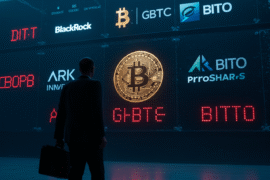This article may contain references to products or services from one or more of our advertisers or partners. We may receive compensation when you click on links to those products or services. Nonetheless, our opinions are our own.
The financial world stands at a crossroads. On one side is the established, heavily regulated traditional banking system that has served as the bedrock of global finance for centuries. On the other hand, Decentralized Finance (DeFi) stands as a rapidly evolving ecosystem of blockchain-based applications that promises to democratize financial services through open-source protocols and decentralized governance. Once viewed as opposing forces, these two financial paradigms are increasingly finding common ground, with integration efforts already underway across multiple fronts.
Understanding the Fundamental Differences
Traditional banking operates within a centralized framework where licensed institutions serve as trusted intermediaries for financial transactions. These banks are subject to strict regulations designed to ensure stability, prevent fraud, and protect consumers. In contrast, DeFi leverages blockchain technology to create trustless systems where financial services—from lending and borrowing to trading and asset management—operate through smart contracts without centralized control.
The traditional system offers stability and consumer protections but often struggles with inefficiency, limited accessibility, and high costs. DeFi promises greater accessibility, transparency, and efficiency but faces challenges related to regulatory compliance, security vulnerabilities, and user experience. These differences have historically positioned them as competitors rather than collaborators.
A similar shift is happening in online gambling, where some platforms are moving away from traditional banking and verification processes. Many of these platforms have implemented minimal or no KYC (Know Your Customer) procedures, allowing users to deposit, wager, and withdraw funds seamlessly with cryptocurrency without undergoing standard identity checks.
Crypto gambling expert Nick Pappas notes that the best no KYC casino sites offer players simplified registration procedures, enhanced privacy, faster payouts, diverse payment methods, thousands of provably fair games, and VIP rewards. By prioritizing privacy and accessibility, these platforms reflect DeFi’s push toward a decentralized financial landscape—though they also come with regulatory and security concerns.
Bridging the Gap: Current Integration Models
The theoretical divide between DeFi and traditional banking is rapidly giving way to practical collaboration as innovative integration models emerge. Financial institutions and blockchain developers are finding creative solutions to combine the strengths of both systems while mitigating their respective weaknesses. These integration approaches range from straightforward custody services to complex tokenization frameworks, each addressing different aspects of the compatibility challenge between centralized and decentralized financial paradigms.
Custody and Asset Servicing
Traditional financial institutions are increasingly offering custody services for digital assets, creating a crucial bridge between conventional financial systems and cryptocurrencies. Major banks like BNY Mellon, State Street, and Standard Chartered have launched digital asset custody solutions, allowing institutional clients to securely hold cryptocurrencies alongside traditional assets. These custody services represent one of the most straightforward integration points, enabling traditional investors to gain exposure to digital assets through familiar, regulated channels.
Banking-as-a-Service Platforms
Banking-as-a-Service (BaaS) platforms are creating modular frameworks where DeFi protocols can connect with traditional banking infrastructure. These platforms provide regulatory-compliant rails for moving money between fiat and crypto systems, enabling DeFi applications to offer seamless on-ramps and off-ramps for users. Companies like Stripe, Plaid, and newer entrants like Wyre and Sardine are building APIs that allow blockchain applications to connect with bank accounts, payment networks, and identity verification systems.
Tokenization of Traditional Assets
The tokenization of real-world assets (RWAs) represents perhaps the most transformative integration model. By creating digital representations of traditional financial instruments — stocks, bonds, real estate, and commodities — on blockchain networks, tokenization enables these assets to interact with DeFi protocols while maintaining their connection to regulated markets. As crypto sees more mainstream uses, projects like Centrifuge, Maple Finance, and Goldfinch have pioneered the tokenization of real-world credit, while major financial institutions are exploring tokenized securities and commercial paper.
Regulatory Frameworks Evolving to Enable Integration
The regulatory landscape of DeFi is shifting as policymakers work to fit blockchain-based finance into existing frameworks. Instead of stifling innovation or allowing unchecked risk, regulators are crafting nuanced approaches that balance DeFi’s unique traits with necessary protections. This evolving environment is opening structured opportunities for traditional banking and DeFi to intersect within compliant boundaries that ensure stability and consumer protection.
Regulatory Sandboxes
Countries including Singapore, the UK, and Switzerland have established regulatory sandboxes where fintech companies can test innovative financial products with real customers under regulatory supervision. These controlled environments allow DeFi projects to experiment with integration models while regulators gain insights into emerging risks and opportunities.
Banking Charters for Crypto Companies
In the United States, Wyoming’s Special Purpose Depository Institution (SPDI) charter and the Office of the Comptroller of the Currency’s (OCC) interpretive letters have created pathways for crypto companies to obtain banking licenses. These frameworks enable digital asset firms to offer banking services while adhering to banking regulations, creating fully compliant hybrid institutions that bridge the traditional and decentralized worlds.
Stablecoin Regulation
Regulatory clarity around stablecoins—cryptocurrencies pegged to traditional currencies—is emerging as a critical factor in DeFi-banking integration. Stablecoins serve as a crucial link between fiat and crypto economies, and clearer regulations around their issuance, reserves, and use cases will facilitate smoother integration between DeFi and banking systems.
Technical Challenges and Solutions
Behind the financial and regulatory considerations are fundamental technical incompatibilities between traditional banking infrastructure and blockchain networks. Centralized banking systems with permissioned access and legacy middleware must interface with DeFi’s open-source protocols, public blockchains, and cryptographic security. Bridging these divides demands engineering solutions that translate between different architectures while ensuring security, efficiency, and reliability.
Interoperability Protocols
Blockchain interoperability protocols are essential for connecting different DeFi ecosystems with traditional financial infrastructure. Projects like Polkadot, Cosmos, and LayerZero are developing cross-chain communication standards that will facilitate seamless integration between various blockchain networks and traditional systems.
Oracle Networks
Oracle networks like Chainlink and Pyth provide reliable data feeds that connect on-chain smart contracts with off-chain information, including price data, interest rates, and other financial metrics from traditional markets. These oracle systems are crucial for DeFi applications that need to reference real-world financial data.
Identity and Compliance Solutions
Solutions that bridge traditional identity verification systems with privacy-preserving blockchain technology are crucial for regulatory compliance. Projects developing zero-knowledge proof systems and decentralized identity frameworks are working to enable compliant KYC/AML processes without compromising the privacy and decentralization principles of DeFi.
Institutional Adoption Driving Integration
What was once viewed as a fringe technology experiment is now attracting serious attention from Wall Street and global financial centers. Institutional players—from investment banks to asset managers and corporate treasuries—are no longer content to observe from the sidelines but are actively exploring ways to harness DeFi’s potential within their existing operations. This institutional embrace represents a crucial validation for decentralized finance and is creating powerful incentives to develop sophisticated bridges between traditional financial services and blockchain-based alternatives.
Treasury Management
Corporations are beginning to allocate portions of their treasury to digital assets, creating demand for infrastructure that connects traditional corporate finance with DeFi yield opportunities. Services like Anchorage Digital, Fireblocks, and Coinbase Prime are building institutional-grade platforms that enable treasurers to deploy capital across both traditional and decentralized finance.
Asset Management
Traditional asset managers are developing products that provide exposure to DeFi, including ETFs, mutual funds, and separately managed accounts focused on digital assets. These products require robust integration between traditional portfolio management systems and on-chain data and transaction capabilities.
Capital Markets Infrastructure
Financial market infrastructure providers are exploring the tokenization of traditional securities and the creation of blockchain-based trading and settlement systems. Projects like DTCC’s Digital Securities Management platform and Switzerland’s SDX digital exchange demonstrate how core capital markets infrastructure is evolving to incorporate blockchain technology.
The Role of Central Bank Digital Currencies
Central Bank Digital Currencies (CBDCs) may serve as a powerful catalyst for DeFi-banking integration. As central banks around the world develop their digital currencies, they are creating programmable money that could seamlessly interact with both traditional financial infrastructure and DeFi protocols. A well-designed CBDC could provide the “official” on-chain representation of fiat currency, potentially eliminating many of the current frictions in moving between traditional and decentralized systems.

Reviewed and edited by Albert Fang.
See a typo or want to suggest an edit/revision to the content? Use the contact us form to provide feedback.
At FangWallet, we value editorial integrity and open collaboration in curating quality content for readers to enjoy. Much appreciated for the assist.
Did you like our article and find it insightful? We encourage sharing the article link with family and friends to benefit as well - better yet, sharing on social media. Thank you for the support! 🍉
Article Title: Can DeFi Be Integrated With Traditional Banking?
https://fangwallet.com/2025/03/03/can-defi-be-integrated-with-traditional-banking/The FangWallet Promise
FangWallet is an editorially independent resource - founded on breaking down challenging financial concepts for anyone to understand since 2014. While we adhere to editorial integrity, note that this post may contain references to products from our partners.
The FangWallet promise is always to have your best interest in mind and be transparent and honest about the financial picture.
Become an Insider

Subscribe to get a free daily budget planner printable to help get your money on track!
Make passive money the right way. No spam.
Editorial Disclaimer: The editorial content on this page is not provided by any of the companies mentioned. The opinions expressed here are the author's alone.
The content of this website is for informational purposes only and does not represent investment advice, or an offer or solicitation to buy or sell any security, investment, or product. Investors are encouraged to do their own due diligence, and, if necessary, consult professional advising before making any investment decisions. Investing involves a high degree of risk, and financial losses may occur including the potential loss of principal.
Source Citation References:
+ Inspo
There are no additional citations or references to note for this article at this time.











































